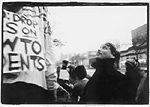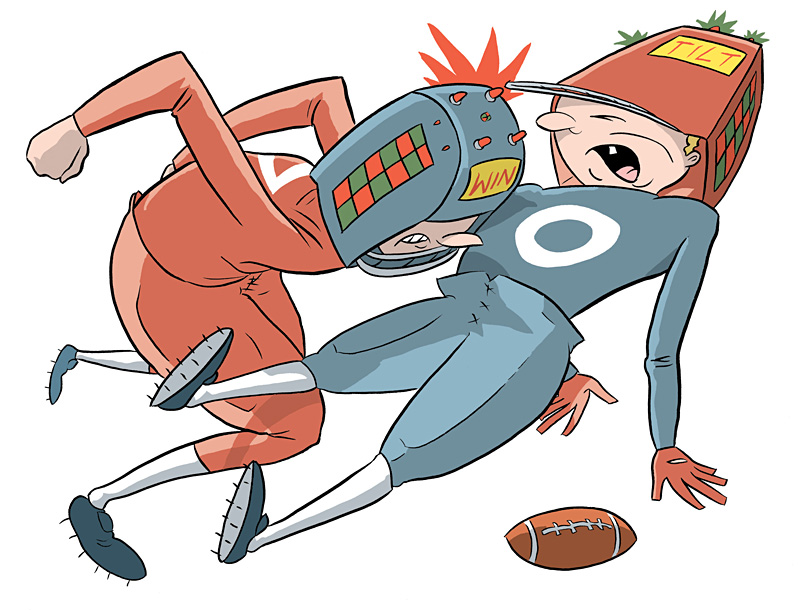There’s little question about what Seattle cops did to people on the street during WTO week. Opinions may vary about the appropriateness of those actions— indeed, a recent Seattle Times poll tells us that Eastsiders think the cops did just swell—but anyone with a television knows that demonstrators, and plenty of passersby, got gassed, tackled, pepper-sprayed, shot with rubber bullets, and (in hundreds of cases) hauled off to King County jail.
A greater, more ominous mystery surrounds the treatment of those protesters once they entered the confines of the jail, hidden from the army of cameras.
Upon the inmates’ release at week’s end, reports immediately began circulating of beatings and other brutality. The level of suspicion has only increased in the days since. Several groups, including the American Civil Liberties Union and the National Lawyers Guild, are doing comprehensive surveys to find out what really happened in jail. Amnesty International has called for an investigation as well.
Interviews with numerous WTO demonstrators by Seattle Weekly seem to suggest that brutality did in fact occur, but the cases appear to have been isolated rather than widespread. The demonstrators who were targeted for harsh treatment were those who were most vocal, took on leadership roles, or refused to cooperate. These people were sometimes put in restraint chairs and isolation cells—or worse.
At least two cases have been brought to the attention of jail officials and could result in legal action against the county.
Keith Holm says he was beaten up by uniformed officers immediately upon arriving at the King County jail on Wednesday of WTO week. “Right as I went in, I was singled out off the bus, along with five others,” says the 35-year-old construction contractor. He claims a half-dozen guards took turns assaulting him. “I was passed around like a hackey-sack. They stomped on my back and on the backs of my knees. They busted my face through a steel door and then through a second glass door. There were clumps of my hair in their fingers. There was nonstop screaming and profanity. They kept asking my name and saying they were going to kill me, going to fuck me up.” Holm maintains he was not resisting at all.
His story is corroborated, at least in part, by witnesses. Jerry Knight, 32, who works as a postal clerk at the Broadway post office, was on the same bus taking Holm and other WTO captives from a processing center at Sand Point to the jail. He says there were a handful of people on the bus, including Holm, who were joking around, helping to keep the prisoners spirits high, as well as instructing them in jail solidarity tactics. One prankster called out to the driver: “Can I get a transfer to Kent?” When the bus arrived at the jail, Knight says, the cop on board demanded, “Who’s the asshole who wanted to get off at Kent?” and proceeded to separate out the half-dozen “troublemakers.”
Inside the jail garage, “there was a lot of shouting and yelling,” says Knight. “The cops told us to keep our heads facing the wall.” Just before he turned away, Knight could see the guards slam Holm’s face into the wall and throw him to the ground. “Then he was separated from us. When I saw him next, several hours later, his face was all bruised up.”
Another witness saw the tail end of the incident. Soph Davenport, a 28-year-old sheet metal worker and union activist, says she was at the check-in desk in the basement of the jail when she heard a “whoomp” at the glass door behind her and turned to see Holm being dragged in and thrown down on a counter, his left arm twisted behind him. “He was bleeding around the eyes,” she says. “They kept saying, ‘Answer the question.’ He was very calmly repeating to them, ‘I’m not a threat to you. I have a heart murmur.'”
Eventually a captain came down and spoke to Holm. His photograph was taken and he gave a statement to the jail’s Internal Investigations unit. He later was released from jail without any charges being filed.
Steve Thompson, the interim director of the King County jail, says he knows of “no incidents where we would intentionally inflict pain on somebody other than as a defensive response.” He says that in the Holm case, as in other cases of alleged WTO abuse, the jail simply has not received any detailed accusations from the inmates. “If you have names of people who are willing to say, ‘Here’s what happened to me,’ and have some specifics, we are ready to roll by fully investigating that,” Thompson says.
“All of our officers have name tags on,” he notes. “We need to have someone come in and say who it was, what time it was. We need to have something beyond just ‘somebody pulled my hair at some point in time.’ There’s not really very much you can do with that.”
Holm was scheduled to speak to jail officials again but did not keep the appointment because of an outstanding federal warrant arising from overdue child support, according to Holm. He says he intends to press criminal charges.
Another WTO demonstrator who left jail with a bloodied face was 38-year-old Clare Corcoran. Corcoran came up to Seattle from San Francisco to set up an art room on Denny Street, where many of the giant puppets and banners used in the WTO demonstrations were built. She found herself on Friday morning inside a cell block in the King County jail with a smashed nose, courtesy, she says, of a male guard who slammed her head into the floor.
Corcoran had been sitting with her arm around her cellmate, a 24-year-old Seattleite who never supplied her real name to the police and who calls herself Sprout. Sprout was refusing to leave the cell, fearful of where the guards would take her. Corcoran was comforting her, as the women that week often did. “I didn’t see it becoming a violent struggle,” says Corcoran, who weighs 100 pounds. “I wasn’t linking arms or anything like that.”
Eventually a female guard entered and tackled Sprout and forced clothes on her, the women say. Then a male guard pulled Corcoran’s arms behind her back and forced her face down to the ground. “I started yelling. All the women [in the cell block] were yelling.” Then another guard pushed her face to the floor, Corcoran says. “There was a lot of blood flowing from my nose.” After a few minutes, the guard released his hold, and shortly afterward Corcoran was taken in shackles to an infirmary and eventually to a hospital, where a radiologist said she’d be OK.
“This is all for jaywalking,” she says, still in disbelief. Corcoran never filed a complaint. She notes that when you’re inside the jail, feeling vulnerable and terrified, “You don’t want to start saying, ‘I’m going to sue you.'” She says she’s still trying to find a lawyer. Meantime, she is presently scheduled to go to trial in February for “failure to disperse,” a misdemeanor.
After the incident, jail officials took Corcoran’s photo as well. Jail director Thompson explains that when somebody claims to have been hurt, “we would want to take photos to use as a reference point.” He says Corcoran and Holm were the only WTO inmates whose photos were taken in this context.
Asked whether these were the only two reports of violence he has seen, Thompson replies, “I’m saying we are in the process of doing after-action reports with complete conclusions on a host of things, and I have not seen other reports on use of force.” He added that he knew of one case in which pepper spray was used on a WTO inmate at the Regional Justice Center in Kent. That inmate, Martin Mijal of Portland, says that pepper foam was rubbed onto his face and into his eyes even after he had been strapped into a restraint chair.
WTO inmates claim to have been brutalized in ways besides outright assault. Both Sprout and another 24-year-old woman from Washington, DC (who likewise never gave her name to jail officials) tell similar stories of being stripped naked by female guards.
Both women were among those who would not cooperate with jail officials, who went limp, refusing to move from the holding cells to the main body of the jail. “I made a decision I wouldn’t be processed until I could speak with an attorney,” says the young woman from DC whose jail number was 987. Sprout says she decided she would not comply after seeing an old woman get yanked by the hair.
Both women were asked several times to move, then were forcibly taken to separate cells within the jail, where a team of female guards held them on the floor, folded their legs behind their backs, and swiftly pulled their clothes off. All the while, says Sprout, “they were saying weird things, schoolyard taunts, like how ugly and dirty our bodies were.” “They were verbally abusing me, calling me a dirty hippie,” says 987. After a few terrifying moments, the guards departed, leaving a set of jail clothes behind. Both women remained in isolation for over 15 hours.
Thompson says the jail does not have solitary confinement but does have areas called “administrative segregation.” “So if people are acting out or causing a disturbance, they would be moved to an ‘ad seg’ cell until their situation is corrected.” He says he is not aware of anyone being stripped. “Strip searches are limited to where there’s evidence of someone introducing contraband,” he says.
By no means did everyone connected to the WTO see or experience abusive behavior in the jail. “In general, from what I saw, the guards were civil . . . whereas the police officers were way over the top,” says Paul Marini, 23, who works at Seattle’s Best Coffee in the Pike Place Market, though he maintains he was denied medical care for his broken arm. Carroll Jackson, a 64-year-old retired school teacher from Seattle says, “All the jailers were very nice to me. I was a cooperative old lady.” Human services worker Henry Hughes, 44, who was incarcerated for three days at the Regional Justice Center in Kent, says, “I personally didn’t see any physical brutality in jail.”
Indeed it’s clear that in some respects the WTO protesters received a degree of special treatment. For example, usually inmates seeking vegetarian meals must supply a signed affidavit from someone outside the jail testifying that they have been a vegetarian for a year. But the jailers supplied vegan peanut-butter-and-jelly sack lunches to anyone who requested them.
Inmates also were given access to their attorneys inside the secure housing area, which is unusual according to attorney Fred Diamondstone, who sued the King County jail 10 years ago for overcrowding.
Perhaps most importantly, the WTO inmates were largely allowed to stay together, separate from the mainstream jail population, which can include hardened felons. “That was a step we took to their benefit,” notes Thompson.
It seems likely that at least some of the shock and outrage is attributable to the fact that many of these inmates were educated, mostly law-abiding individuals who had never experienced the brute harshness of incarceration. Linda Warren, a 52-year-old philosophy teacher at Shoreline Community College, says that to be in leg irons and sleep on the cement floor with a paper bag under her head “was a very shocking experience for me.” She says her wrists still hurt from the pain holds used by the guards.
Nonetheless, she recalls one prisoner saying to her: “You should see what it’s like when you’re not here.”








